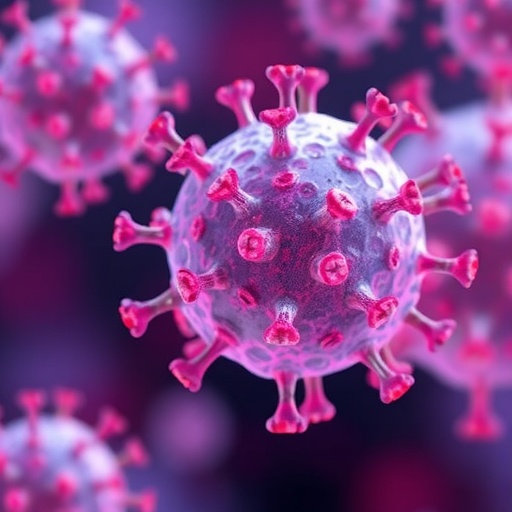A Groundbreaking Antiviral Discovery: How Epigallocatechin-3-Gallate Restores Host Epigenetic Integrity to Combat Influenza A Virus
In the relentless battle against influenza A, a virus notorious for its rapid mutation rates and virulence, researchers have identified a novel mechanism to thwart infection by leveraging the host’s own epigenetic machinery. A recent study published in International Microbiology unveils the potent antiviral properties of epigallocatechin-3-gallate (EGCG), a polyphenolic compound found predominantly in green tea, demonstrating its ability to inhibit influenza A virus replication by restoring the methylation status of host genes compromised during infection.
The influenza A virus presents a formidable challenge due to its capacity to subvert host cellular processes, facilitating viral proliferation and evasion of immune surveillance. One critical strategy employed by the virus is the modulation of host epigenetic marks—chemical tags that regulate gene expression without altering the DNA sequence. DNA methylation, a key epigenetic modification, has been shown to be disrupted upon influenza infection, resulting in dysregulated expression of genes critical to the antiviral response.
This pioneering research delves into the intricate interplay between influenza A virus infection and host DNA methylation patterns. The authors highlight that viral replication is associated with widespread hypomethylation of specific genomic regions, leading to the silencing of antiviral defense genes. By systematically mapping these epigenetic changes, the study reveals how influenza commandeers the host’s genome, effectively turning off its own antiviral arsenal.
EGCG emerges as a molecule of significant interest due to its multifaceted bioactivity. Previously recognized for its antioxidant and anti-inflammatory effects, this study places EGCG at the forefront of antiviral research by demonstrating its capacity to re-establish proper methylation landscapes in infected cells. Through returning DNA methylation to its physiological state, EGCG promotes the reactivation of genes that play central roles in mounting an effective antiviral response, thereby curbing viral replication.
Methodologically, the investigation employed cutting-edge techniques including methylation-specific PCR and bisulfite sequencing to assess DNA methylation changes at a genome-wide scale in cells infected with influenza A virus. Treatment with EGCG was found to reverse hypomethylation patterns and restore expression levels of key genes involved in interferon signaling and innate immunity pathways. These findings solidify the link between epigenetic modulation and host defense against viral pathogens.
Further mechanistic analyses unraveled that EGCG likely influences the activity of DNA methyltransferases (DNMTs), the enzymes responsible for catalyzing the addition of methyl groups to DNA. Influenza infection appears to downregulate DNMTs, compromising the epigenetic stability of host cells. EGCG treatment reactivates these enzymes, suggesting a molecular axis through which this compound mediates its antiviral effects.
The implications of this discovery are profound, as they introduce an epigenetics-based therapeutic strategy complementary to conventional antiviral drugs. Unlike agents that directly target viral components—which often succumb to resistance due to viral mutations—modulating host epigenetics offers a more robust approach with potentially broad-spectrum activity. EGCG’s ability to preserve the host’s gene regulatory network ensures a sustainable antiviral state that is less likely to be circumvented by viral evolution.
In exploring the influence of EGCG on the host immune landscape, the study also noted an upregulation of genes encoding cytokines and chemokines integral to orchestrating immune cell recruitment. This suggests that beyond suppressing viral replication, EGCG may enhance the overall immunocompetence of infected hosts. Such dual action could prove invaluable in managing influenza infections, which are often complicated by secondary infections and immune dysregulation.
Remarkably, EGCG’s efficacy was substantiated in both in vitro cell cultures and in vivo models. Animals administered EGCG exhibited decreased viral loads and attenuated lung pathology, aligning with the molecular evidence of restored DNA methylation. These translational findings underscore the therapeutic potential of EGCG not only as a preventive dietary supplement but as a candidate for drug development against influenza.
The study also prompts re-examination of green tea polyphenols’ role in respiratory viral infections historically documented in epidemiological research. While green tea consumption has been correlated with reduced incidence of colds and flu-like symptoms, this investigation provides molecular validation, elucidating how EGCG could exert these protective benefits through epigenetic remodeling.
Importantly, the research opens avenues for investigating whether other viral pathogens similarly disrupt host epigenetics as part of their infection strategy. If so, EGCG or analogous compounds may serve as universal epigenetic modulators, capable of fortifying host defenses against a wide array of viruses, including emerging threats such as novel influenza strains or coronaviruses.
Moreover, the study raises intriguing prospects for personalized medicine. Epigenetic profiles vary among individuals influenced by genetics, environment, and lifestyle; understanding how these differences impact susceptibility to viral epigenetic hijacking could enable tailored interventions where EGCG supplementation is optimized for those most at risk.
In terms of safety, EGCG is generally regarded as non-toxic at physiologically relevant doses, which facilitates its translational potential. However, the researchers emphasize the need for controlled clinical trials to evaluate pharmacokinetics, dosage optimization, and long-term effects when used specifically for antiviral therapy.
Ultimately, this work not only advances our understanding of virus-host interactions but also exemplifies the therapeutic promise of natural products in modern medicine. By harnessing the epigenetic restoration capabilities of EGCG, we may be on the cusp of a paradigm shift in antiviral strategy—one that empowers hosts to reclaim control from viral pathogens through their own genomic regulation.
As the influenza virus continues to challenge public health worldwide, such innovative approaches are vital. The discovery of EGCG’s role in preserving methylated gene integrity heralds a new chapter in combating viral diseases, illuminating a path toward treatments that are as elegant as they are effective—rooted in the fundamental biochemistry of life itself.
Subject of Research: The inhibitory effects of epigallocatechin-3-gallate on influenza A virus replication through restoration of host DNA methylation patterns after infection.
Article Title: Epigallocatechin-3-gallate inhibits replication of influenza A virus via restoring the host methylated genes following infection.
Article References:
Bery, D.E., El-Masry, S.A., Guirgis, A.A. et al. Epigallocatechin-3-gallate inhibits replication of influenza A virus via restoring the host methylated genes following infection.
Int Microbiol (2025). https://doi.org/10.1007/s10123-025-00655-6
Image Credits: AI Generated




